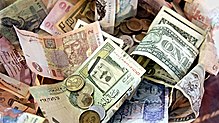
Back التدخل في العملة Arabic Měnová intervence Czech Devisenmarktintervention German مداخله ارزی Persian Interventions sur le marché des changes French Idirghabháil sa mhargadh airgeadraí Irish Արժութային միջամտություն Armenian 外国為替平衡操作 Japanese 통화개입 Korean Interwencja walutowa Polish
| Foreign exchange |
|---|
| Exchange rates |
| Markets |
| Assets |
| Historical agreements |
| See also |


Currency intervention, also known as foreign exchange market intervention or currency manipulation, is a monetary policy operation. It occurs when a government or central bank buys or sells foreign currency in exchange for its own domestic currency, generally with the intention of influencing the exchange rate and trade policy.
Policymakers may intervene in foreign exchange markets in order to advance a variety of economic objectives: controlling inflation, maintaining competitiveness, or maintaining financial stability. The precise objectives are likely to depend on the stage of a country's development, the degree of financial market development and international integration, and the country's overall vulnerability to shocks, among other factors.[1]
The most complete type of currency intervention is the imposition of a fixed exchange rate with respect to some other currency or to a weighted average of some other currencies.
- ^ Joseph E. Gagnon, “Policy Brief 12-19”, Peterson Institute for International Economic, 2012.
© MMXXIII Rich X Search. We shall prevail. All rights reserved. Rich X Search